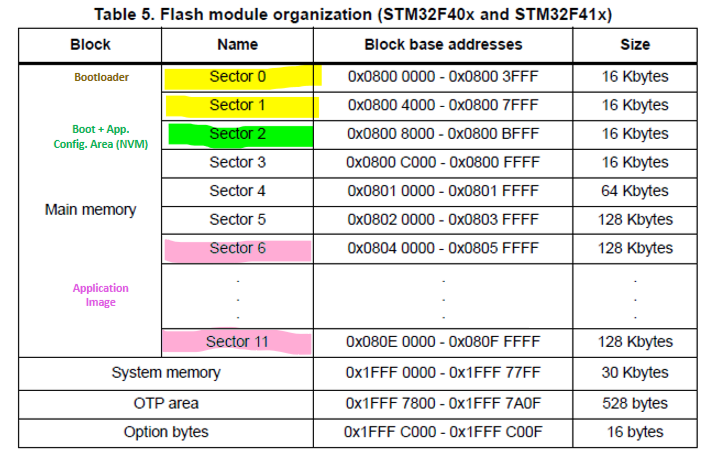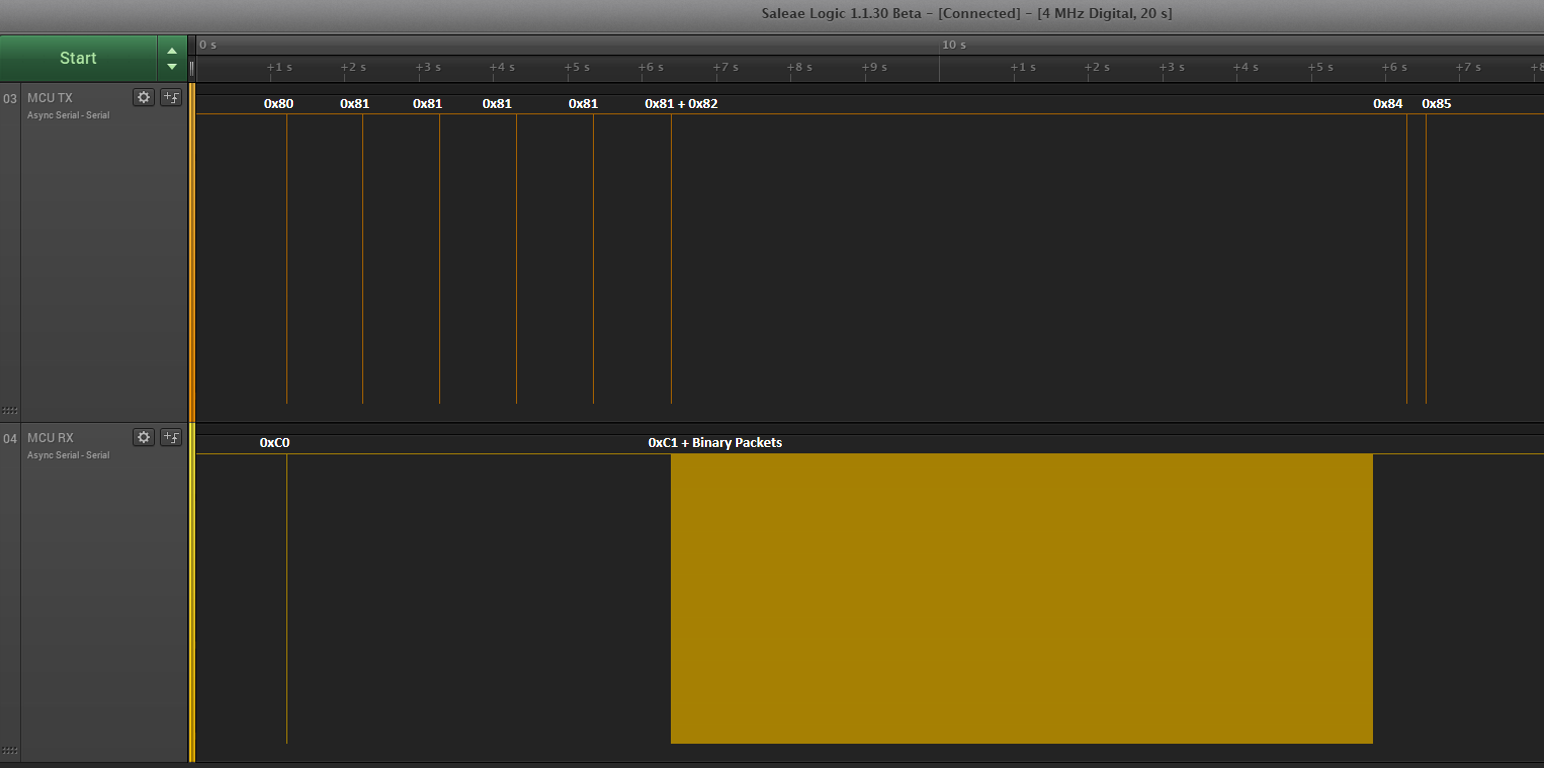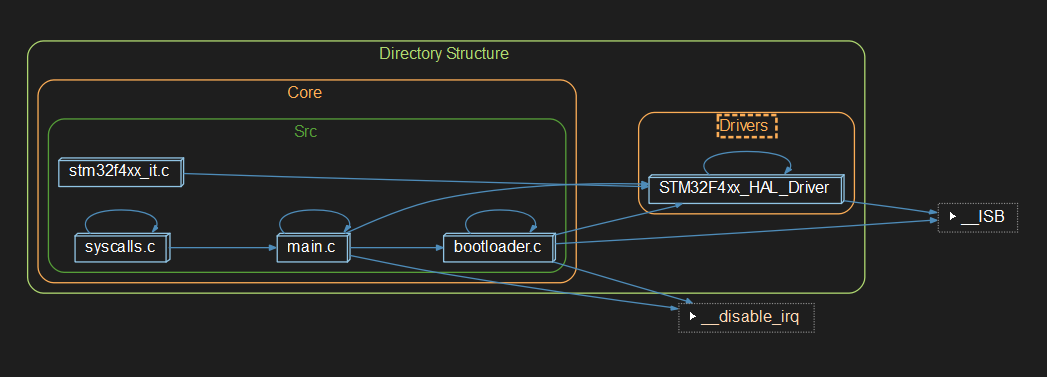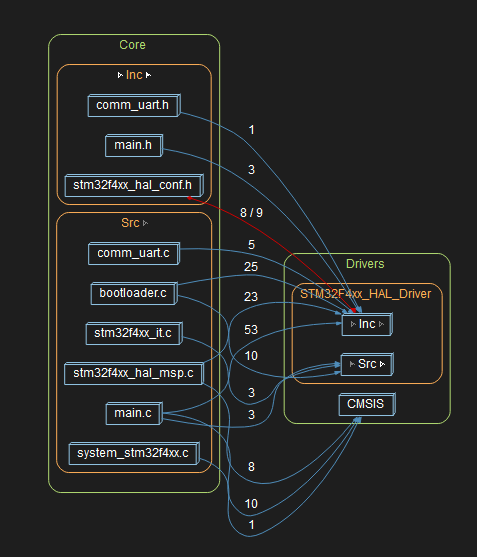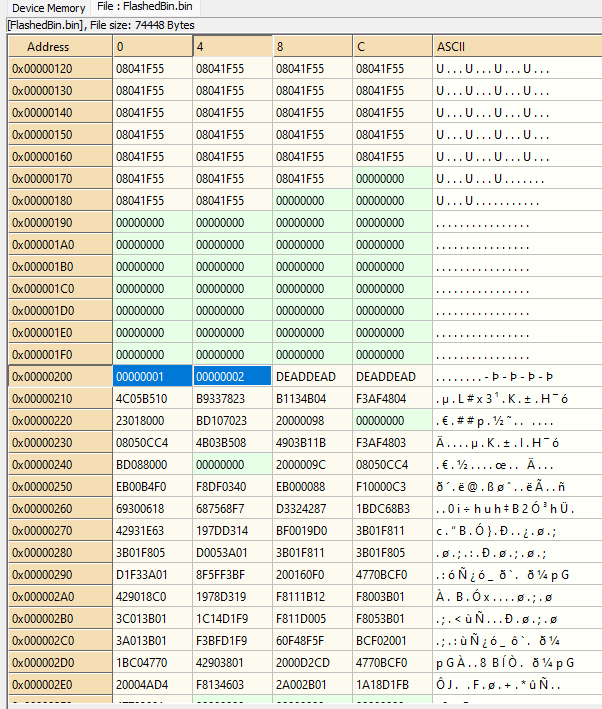This project consists in a simple bootloader w/ flashing functionality.
If the STM32 board is connected to the computer via the serial / UART interface (through a UART ->serial USB adapter), a new binary can be flashed by pressing the "Reset Button" of the board while running the Python Flash Loader (submodule inside Python_STM32_Bootloader_Flasher folder).
The memory layout for this project is as follows:
Bootloader Memory:
- Start Address: 0x0800 0000
- End Address: 0x0800 7FFF
- Size: 32KB
- Sectors: 0+1
Persistent Shared Config Memory:
- Start Address: 0x0800 8000
- End Address: 0x0800 BFFF
- Size: 16KB
- Sectors: 2
Application Memory:
- Start Address: 0x0804 0000
- End Address: 0x080F FFFF
- Size: 768KB -Sectors: 6 to 11
Memory Layout Table:
The protocol used for flashing new SW and checking for updates is a customized protocol created just for this project. The behavior is as follows:
Whenever the MCU sends a command to the computer, it'll wait for 1000ms for an answer. If not answered, the MCU will throw and error and/or try to proceed to the application phase, depending on the state of the comunication.
Start of communication + Receive SW version and size:
- MCU: 0x80 FF FF FF -> MCU will always send a 0x80 in the MSB after a reset or power-on takes place, indicating that the MCU is in the bootloader phase. Bytes 1,2,3 (LSB) values don't care.
- PC: 0xC0 mj mn FF -> If the loader is running, PC will answer with a 0xC0 in the MSB (0x80 + 0x40), indicating that a serial communication is available and new SW might be flashed. The software MAJOR and MINOR version will be provided in bytes 1 and 2 respectively. Depending on the bootloader preprocessor directives, a repeated SW may be accepted or skipped.
- MCU: 0x81 xx yy FF -> If new SW is accepted, the MCU starts to erase each memory sector. The sector being currently erased is displayed through bit 1. Byte 3 will turn from zero (0) to one (1) when all app. dedicated sectors were erased.
- PC: 0xC1 xx xx xx -> After all app. dedicated sectors were erased, the PC will acknowledge with a 0xC1 in the MSB (0x81 + 0x40), indicating the number of packets that will be provided to flash the new SW binary in the bytes 1 to 3 (LSB).
- MCU: 0x82 xx xx xx -> MCU confirms that it can receive the provided number packets (0x82). It'll also replicate / acknowledge the number of expected packets to be received in the bytes 1 to 3 (LSB).
Start of communication - Error Codes / Skip Codes
- MCU: 0x80 FF FF FF -> PC receives a 0x80 in the MSB, indicating that a MCU is present in the bootloader phase. Bytes 1,2,3 (LSB) don't care.
- PC: 0xC0 mj mn FF -> PC answers with a 0xC0 in the MSB (0x80 + 0x40), indicating that a serial communication is available and new SW might be flashed. The software MAJOR and MINOR version will be provided in bytes 1 and 2 respectively.
- MCU: 0x8E FF FF FF -> MCU current software matches the current software to be flashed. Skipping flash procedure, jumping to application directly.
Binary data streaming (loop - normal operation):
- PC: 0xyy yy yy yy -> PC sends the 4-byte package containing the SW binary contents. ... procedure repeated until all expected packets are sent.
Binary data streaming (loop - error operation):
- PC: 0xyy yy yy yy -> 4-byte package containing the SW binary.
- MCU: 0x8F FF FF FF -> Error - MCU couldn't flash the last packet provided / generic error. Aborting flash.
End of transmission
- MCU: 0x84 00 xy zw -> MCU informs that the transmission has been completed and returns the checksum (CRC16) of the whole flashed binary in bytes 2 and 3. The computer is responsible for checking the CRC plausibility.
Jump to application
- MCU: 0x85 FF FF FF ->MCU informs bootloader routine is finished, application SW is to be started.
Example of 0x80 - MCU opening communication:
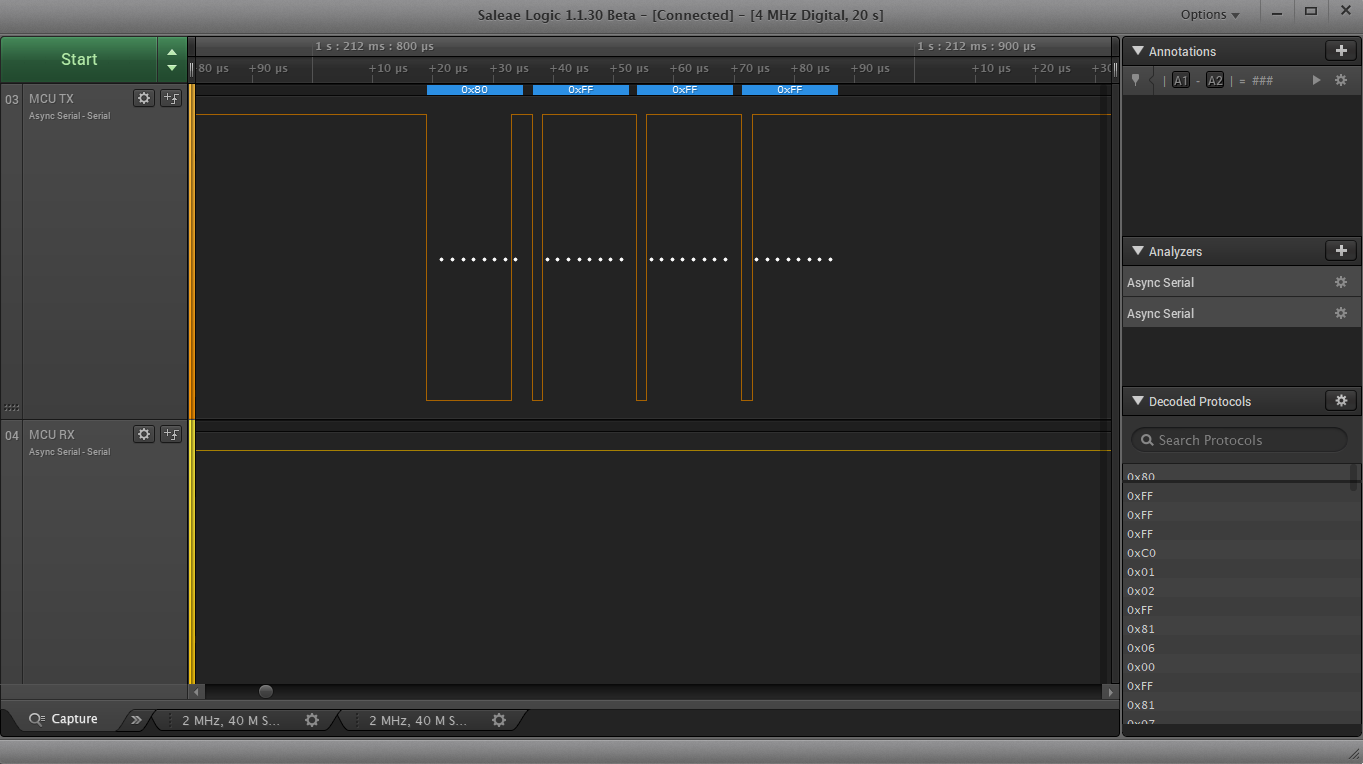
Example of binaries being tranmitted:
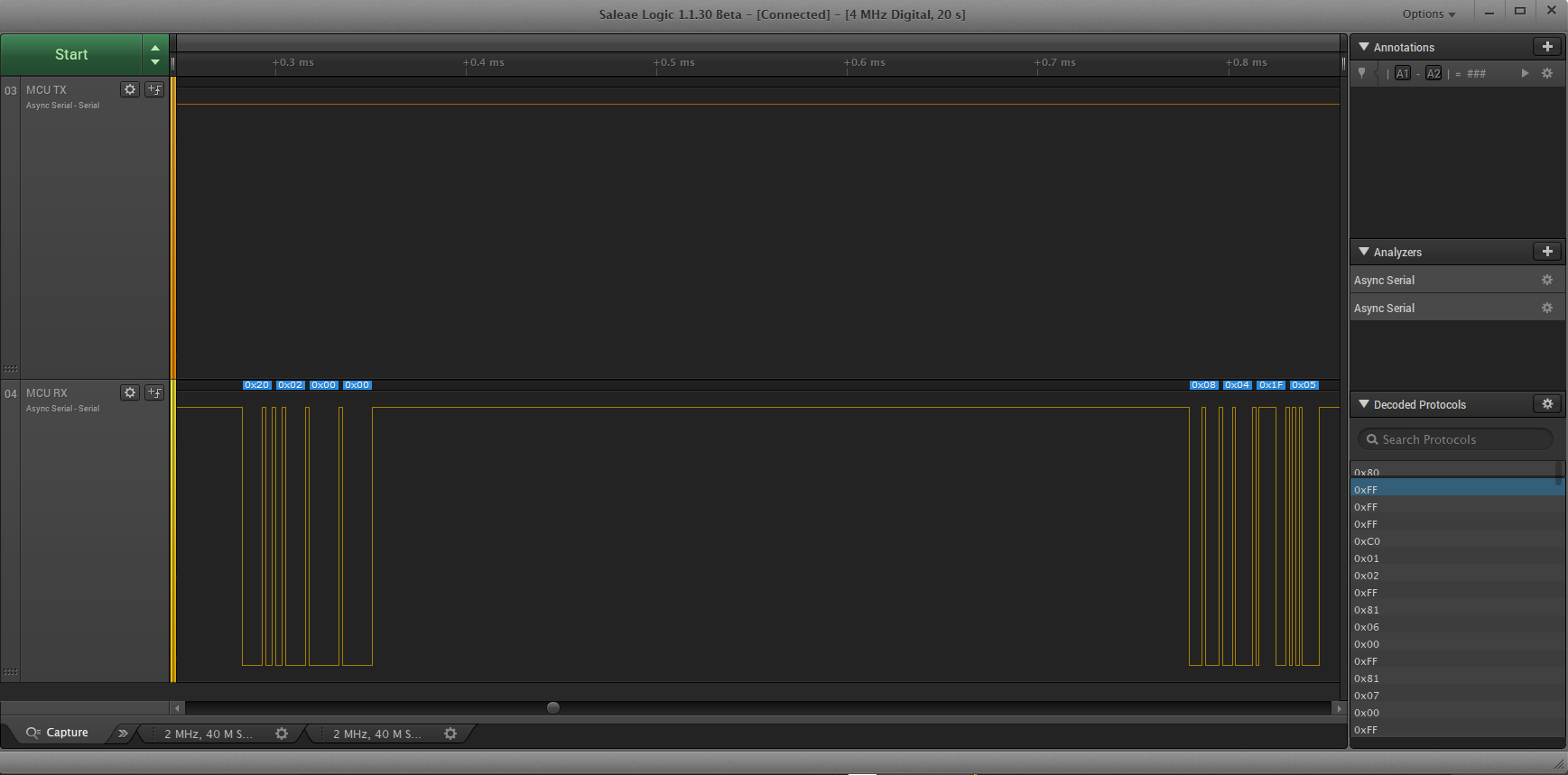
Requirement 1: As per currently configured, an application image is expected to start in address 0x0804000.
Requirement 2: An application binary is also expected to carry into its code the current SW_Major and SW_Minor version as uint32_t data objects into the binary addresses 0x200 and 0x204 respectively, as per the image below (Major = 1 and Minor = 2):
The applications used in conjunction with this bootloader have the following linker specifications (linker file STM32xxx_FLASH.ld) to match the upper requirements:
/* ... linker file upstream Memories definition *** */
/* Memories definition */
MEMORY
{
CCMRAM (xrw) : ORIGIN = 0x10000000, LENGTH = 64K
RAM (xrw) : ORIGIN = 0x20000000, LENGTH = 128K
FLASH (rx) : ORIGIN = 0x8040000, LENGTH = 512K /* Init. Address offset + adjusted length*/
}
/* ... linker file downstream Memories definition *** */
SECTIONS {
/* ... sections upstream .config_data *** */
.config_data : /* This memory sector is used for the binary file to carry SW related data (header) */
{
. = ORIGIN(FLASH) + 0x0200; /* SW config data initial address - Fixed address from memory start */
KEEP(*(.config_data)) /* SW config data */
. = ORIGIN(FLASH) + 0x0210;
} >FLASH
/* ... sections downstream .config_data *** */
}